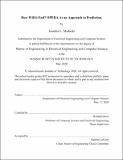How will it end? OPERA as an approach to prediction
Author(s)
Madiedo, Jennifer L.
Download1192967483-MIT.pdf (4.995Mb)
Other Contributors
Massachusetts Institute of Technology. Department of Electrical Engineering and Computer Science.
Advisor
Randall Davis.
Terms of use
Metadata
Show full item recordAbstract
Developing a computational account of human intelligence requires understanding and modeling human story understanding faculties, including the human ability to make predictions. When presented with a novel situation, people can generalize their past experiences and apply them to propose a reasonable prediction about potential outcomes of that situation. The goal of this work is to develop a novel approach to develop this reasoning capability. We present character alignment as a new approach to outcome prediction. We claim that if you can capture a character's behavior and motivations in a story, you can use that information to make predictions about a similar character in the future. Inspired by work on reasoning by analogy and story alignment, our system uses the character alignment approach to create representations of characters as it reads stories and uses those representations to predict what a character in a new story might do. Our representations are action oriented, i.e., focused on how a given character interacts with other characters and the specific actions they take. We claim that this focus on character representations is valuable in part for its efficiency: It enables reasoning with only key parts of stories rather than the entire story. To demonstrate this approach in action, we designed and developed OPERA, a system that makes predictions about story outcomes. Built on top of the Genesis system, OPERA gathers information about characters in the short stories that it reads (approx. 60-70 sentences long). For each story, the system creates representations for each character by extracting information about them and their interactions. This information includes their desires, the actions they take, and the goals they achieve. When prompted with a specific character in the story, the system uses its representation of characters to predict the outcome for that character. This method has advantages over existing approaches, such as story alignment, because it focuses on key parts of the story (specifically those in character representations) and can combine and generalize information from multiple sources. This work gives Genesis the ability to efficiently draw connections from past experiences, recognize similarities, and make informed predictions..
Description
Thesis: M. Eng., Massachusetts Institute of Technology, Department of Electrical Engineering and Computer Science, May, 2020 Cataloged from the official PDF of thesis. Includes bibliographical references (pages 116-118).
Date issued
2020Department
Massachusetts Institute of Technology. Department of Electrical Engineering and Computer SciencePublisher
Massachusetts Institute of Technology
Keywords
Electrical Engineering and Computer Science.